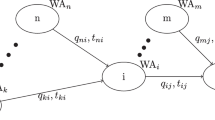Abstract
In this paper we solve a constrained optimal control problem related to the location of the wastewater outfalls in a sewage disposal system. This is a problem where the control is the position and the constraints are non-convex and pointwise, which makes difficult its resolution. We discretize the problem by means of a characteristics-Galerkin method and we use three algorithms for the numerical resolution of the discretized optimization problem: an interior point algorithm, the Nelder-Mead simplex method and a duality method. Finally, we compare the numerical results obtained by applying the described methods for a realistic problem posed in the ría of Vigo (Galicia, Spain).
Similar content being viewed by others
References
J.J. Alibert and J.P. Raymond, “A Lagrange multiplier theorem for control problems with state constraints,” Numer. Funct. Anal. and Optimiz., vol. 19, pp. 697–704, 1998.
W. Alt, “The Lagrange-Newton method for infinite-dimensional optimization problems,” Numer. Funct. Anal. and Optimiz., vol. 11, pp. 201–224, 1990.
W. Alt, “The Lagrange Newton method for infinite-dimensional optimization problems,” Control and Cybernetics, vol. 23, pp. 87–106, 1994.
W. Alt, “Discretization and mesh independence of Newton's method for generalized equations,” in Mathematical Programming with Data Perturbation. A.K. Fiacco (Ed.), Lecture Notes in Pure and Appl. Math., Marcel Dekker: New York, vol. 195, 1998, pp. 1–30.
V. Barbu, Analysis and Control of Nonlinear Infinite Dimensional Systems, Academic Press: Boston, 1993.
M. Bergounioux and K. Kunisch, “Augmented Lagrangian techniques for elliptic state constrained optimal control problems,” SIAM J. Control Optim., vol. 35, pp. 1524–1543, 1997.
D.B. Bertsekas, “Projected Newton methods for optimization problems with simple constraints,” SIAM J. Control Optim., vol. 20, pp. 221–246, 1982.
E. Casas, “Pontryagin's principle for state-constrained boundary control problems of semilinear parabolic equations,” SIAM J. Control Optim., vol. 35, pp. 1297–1327, 1997.
H. Goldberg and F. Tröltzsch, “Second order sufficient optimality conditions for a class of nonlinear parabolic boundary control problems,” SIAM J. Control Optimization, vol. 31, pp. 1007–1025, 1993.
H. Goldberg and F. Tröltzsch, “On a SQP-Multigrid technique for nonlinear parabolic boundary control problems,” in Optimal Control: Theory, Algorithms, and Applications, W.W. Hager and P.M. Pardalos (Eds.), Kluwer Academic Publishers B.V., 1998, pp. 154–177.
W.W. Hager, “Approximations to the multiplier method,” SIAM J. Numer. Analysis, vol. 22, pp. 16–46, 1985.
W.W. Hager, “Multiplier methods for nonlinear optimal control” SIAM J. Control Optimization, vol. 27, pp. 1061–1080, 1990.
M. Heinkenschloss and E.W. Sachs, “Numerical solution of a constrained control problem for a phase field model,” Control and Estimation of Distributed Parameter Systems, Int. Ser. Num. Math., vol. 118, pp. 171–188, 1994.
A.D. Ioffe, “Necessary and sufficient conditions for a local minimum, part 3: Second order conditions and augmented duality,” SIAM J. Control Optimization, vol. 17, pp. 266–288, 1979.
A.D. Ioffe and Tikhomirov, Theory of Extremal Problems, North Holland: Amsterdam, 1979.
K. Ito and K. Kunisch, “Augmented Lagrangian-SQP methods for nonlinear optimal control problems of tracking type,” SIAM J. Control Optim., vol. 34, pp. 874–891, 1996.
K. Ito and K. Kunisch, “Augmented Lagrangian-SQP methods in Hilbert spaces and application to control in the coefficients problems,” SIAM J. Optim., vol. 6, pp. 96–125, 1996.
A. Kauffmann, “Optimal control of the solid fuel ignition model,” Thesis, Technical University of Berlin, Oct. 1998.
K. Kunisch and S. Volkwein, “Augmented Lagrangian-SQP techniques and their approximations,” Contemporary Mathematics, vol. 209, pp. 147–159, 1997.
O.A. Ladyzenskaja, V.A. Solonnikov, and N.N. Ural'ceva, “Linear and quasilinear equations of parabolic type,” Translations of Mathematical Monographs, 23, Amer. Math. Soc., Providence, R.I., 1968.
H. Maurer, “First and second order sufficient optimality conditions for infinite-dimensional programming problems,” Math. Programming, vol. 16, pp. 98–110, 1979.
H. Maurer and J. Zowe, “First and second-order necessary and sufficient optimality conditions in mathematical programming and optimal control,” Math. Programming Study, vol. 14, pp. 163–177, 1981.
J.P. Raymond and F. Tröltzsch, “Second order sufficient optimality conditions for nonlinear parabolic control problems with state constraints,” Disc. Cont. Dyn. Systems, vol. 6, pp. 431–450, 2000.
J.P. Raymond and H. Zidani, “Hamiltonian Pontryagin's principles for control problems governed by semilinear parabolic equations,” Appl. Math. Optim., vol. 39, pp. 143–177, 1999.
S.M. Robinson, “Strongly regular generalized equations,” Math. of Operations Research, vol. 5, pp. 43–62, 1980.
F. Tröltzsch, “On the Lagrange-Newton method for the optimal control of semilinear parabolic equations,” SIAM J. Optim., vol. 38, pp. 294–312, 1999.
F. Tröltzsch, “Lipschitz stability of solutions to linear-quadratic parabolic control problems with respect to perturbations,” Dynamics of Continuous, Discrete and Impulsive Systems, vol. 7, pp. 289–306, 2000.
A. Unger, “Hinreichende Optimalitätsbedingungen 2. Ordnung und Konvergenz des SQP-Verfahrens für semilineare elliptische Randsteuerprobleme,” Thesis, Technical University of Chemnitz, Dec. 1997
S. Volkwein, “Mesh-independence for an augmented Lagrangian-SQP method in Hilbert spaces,” SIAM J. Optim., vol. 38, pp. 767–785, 2000.
S. Volkwein, “Distributed control problems for the Burgers equation,” Computational Optimization and Applications, vol. 18, pp. 115–140, 2001.
Author information
Authors and Affiliations
Rights and permissions
About this article
Cite this article
Alvarez-Vázquez, L., Martínez, A., Rodríguez, C. et al. Numerical Optimization for the Location of Wastewater Outfalls. Computational Optimization and Applications 22, 399–417 (2002). https://doi.org/10.1023/A:1019767123324
Issue Date:
DOI: https://doi.org/10.1023/A:1019767123324




